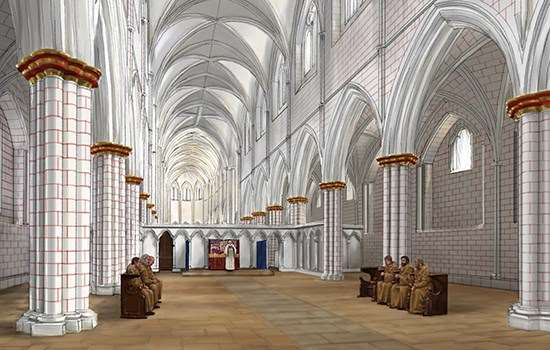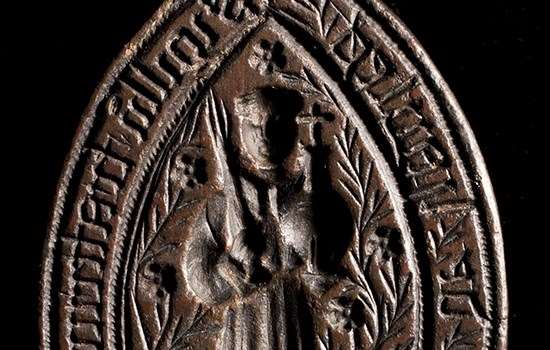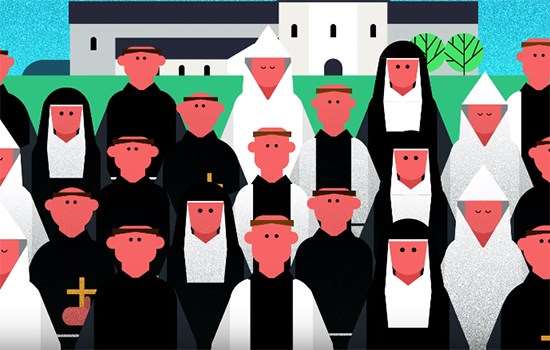What were visitations?
The community at Hailes was led by a father abbot, to whom the monks owed total obedience. Periodically, the abbot of another Cistercian monastery would visit Hailes to examine the conduct of the abbot and monks. The records of numerous visitations conducted at Hailes between the mid-13th and mid-15th centuries survive.
Visitations followed a set procedure, with every aspect of life within a monastery and the behaviour of the monks scrutinised. By their very nature, visitations were meant to find fault and no error was too small to attract the censure of a visiting abbot. At the end of the visitation, the findings were carefully recorded and read to the monks assembled in the chapter house.
Minor Misdemeanours
According to St Bernard of Clairvaux – the greatest of all Cistercian saints – living as part of a community within a monastery provided an opportunity to experience the angelic life on earth. However, the visitation records can leave no doubt that the monks at Hailes did not always achieve this high standard. The monks were admonished for ganging up against one of their brethren and gossiping about allegations of his sexual wrongdoing, which had been disproven. On another occasion, there was a serious falling out between the abbot and many of his monks.
The visiting abbot often highlighted minor lapses in religious observance. The Hailes monks were admonished for not kneeling deeply enough in front of the high altar, for failure to celebrate a daily Mass in honour of the Virgin Mary, to whom the abbey was dedicated, and for the quality of their chant during the eight services that punctuated the monastic day – hurrying or slurring words, for instance, was criticised. On one occasion, the visiting abbot complained that a hymn needed to be sung at a higher pitch to ensure that it was a song of praise rather than a miserable dirge.
Reading, Sleeping, Drinking
All Cistercian monks were expected to be Latin literate and to spend a portion of each day reading religious books in the cloister. The visiting abbot instructed that monks should be given books that were appropriate to their level of learning, with less knowledgeable monks allocated books that provided instruction about the rules of the Cistercian order. The monks of Hailes were also warned not to leave the cloister during the time allocated to reading. Transgressing monks were to be beaten before the assembled community at the daily meeting in the chapter house, a typical punishment for minor infringements of monastic rules.
When Hailes was founded in the mid-13th century, the monks slept in a communal dormitory, as mandated in the Rule of St Benedict. But by the mid-14th century, it was common practice for monks to live in individual cells. In 1394, the community at Hailes were told they must not sleep in such private chambers. It appears however that such instructions were ignored – the monks insisting on the comfort and privacy afforded by individual cells.
Monks, of course, were expected to be celibate. Concern for the sexual morality of the community was a recurring theme in the visitations. Although the visiting abbots recorded no proven sexual misdemeanours, they highlighted circumstances which could lead to allegations of such behaviour. Women, for instance, were lodging within the precinct of the monastery and monks were expressly forbidden to wander off and visit local taverns.
Care and Charity
Visiting abbots also criticised aspects of the administration of the abbey by the abbot and other senior monks. The faults found included the accumulation of debts, the shabby clothing of the monks, the quality of care provided for sick monks in the infirmary, failure to provide charity to the poor, the disrepair of the monastery’s buildings and permitting weeds and thistles to grow in the cloister.
Taken together, the visitations record many breaches of monastic discipline. But modern scholars should resist the temptation to judge the monks too harshly. The Rule of St Benedict and the regulations of the Cistercian order set exacting standards. The very fact that they include provisions for the correction of errors and the rehabilitation of erring monks shows that it was expected that some brothers would struggle to live up to the high standards demanded of them.
Read More
-

History of Hailes Abbey
Discover the full story of Hailes Abbey, from its foundation in the 13th century to its downfall under Henry VIII and subsequent rediscovery in the 19th century.
-

The Holy Blood of Hailes
The fortunes of Hailes Abbey were transformed by the arrival of a holy relic. Learn how the Holy Blood of Hailes contributed to both the rise and fall of the monastery.
-

A mini guide to Medieval Monks
Do you know the difference between the Benedictines, Cluniacs, Carthusians and Cistercians? This short animation will guide you through the different religious communities in medieval Britain.
